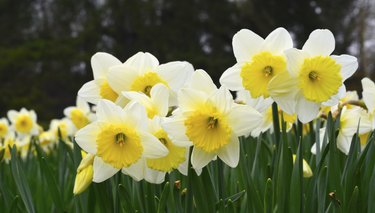
Low-maintenance and dependable, daffodils (Narcissus spp.) welcome spring with their bright yellow flowers. Daffodils grow in U.S. Department of Agriculture plant hardiness zones 4 through 8, depending on the variety. Although they are relatively low-maintenance, some timely care after they bloom and during their summer and fall dormant season helps ensure healthy, large blooms next year.
A Timely Trim
Video of the Day
The process of making a seed weakens a daffodil bulb, expending all the carefully stored energy that would otherwise go to next year's bloom. Cut off the dead flower as soon as the petals wilt but leave the green stem and leaves on the plant to continue soaking up the sun. Wipe your shears with a cloth soaked in rubbing alcohol to disinfect them before you prune. Cut down the old leaves to the soil after they begin yellowing, about six weeks after blooming. Rake up and dispose of the dead leaves after trimming. Planting a few annual flowers around the daffodil bed distracts from the dying foliage and helps prevent the temptation to cut it down early.
Video of the Day
Divide and Thrive
Daffodils need to be divided every three or four years. If the plants seem crowded and aren't flowering well, it's time to divide. Loosen the soil and lift the bulbs right after you cut down the foliage. You can wait until fall, but it's more difficult to find the bulbs after they go fully dormant. Small new bulbs are often attached to the larger "mother" bulbs. Twist these apart and save the largest for replanting. Toss any that are damaged, diseased, soft or shriveled. Replant the daffodils in well-draining soil in full sun, spacing them about 6 inches apart and setting them with their points facing up, about 3 inches beneath the soil.
Keep Them Fed
Keeping the daffodils supplied with nutrients helps them stay productive and attractive each year. Daffodils don't require fertilizer right after they bloom, although you can work 1 to 2 tablespoons of bonemeal into the bottom of the planting hole during division. The bonemeal supplies additional phosphorus, which helps fuel flowering. Otherwise, wait until mid-fall for a fertilizer application. Sprinkle 1/2 pound of a balanced 10-10-10 fertilizer blend over every 50 feet of garden bed. Water lightly after application so the nutrients can start soaking into the soil.
Chill Out
Getting the bulbs ready for winter depends on where you live. In cold climates, where temperatures reliably remain below 50 degrees Fahrenheit for at least 12 weeks, an insulating 2- to 3-inch layer of mulch is all the plants need. In warmer climates, mark the location of the bulbs right after they flower so you can more easily find them in fall. Dig up the bulbs each fall, dividing if necessary, and pack them in a handful of peat moss in a perforated plastic bag. Store the bags in a refrigerator, keeping them away from ripening fruits and vegetables, which can cause the bulbs to rot. Replant the daffodil bulbs in late winter, after a 12- to 16-week chilling period.